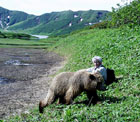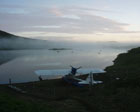
Chico and Biscuit are very playful this year. They spend a lot of time
chasing each other and seem very happy.

You can see how wonderfully relaxed Biscuit is around us and you can also
see that we are not betting on her being unpredictable.

While I was writing, Maureen spotted the cubs high on the mountain, to
the east of the cabin, playing on a snow bank that comes all the way to
the lake. They were chasing, wrestling and sliding. Other years they had
a slight concerned air in the spring as though life was weighing on them
a bit. They are still acting like siblings so it is quite obvious that
they are not ready to go out and meet a male bear with mating in mind.

This is the fifth year, that the Kolb has been parked in this spot. You
can see the simple electric fence that has protected it for that time.
Of course there are times like it is now as I write, one day after I took
this photo, when the lake is whipped into a froth and I have to occasionally
check if the hold down ropes are tight.
(Click on any Image to see a higher resolution version)
This web site is a good place for us to get feedback on how our work here in Russia is perceived by others all over the world. So far it seems to be positive. Occasionally, I look at what has happened over the last five years and try to see what we could look at with fresh knowledge and what needs more work towards gaining a better understanding. Not having new cubs to work with this year has required that we refocus on what there is yet to learn from Chico and Biscuit, Brandy and her offspring. This is undoubtedly a good thing as there seems to be no limits in this regard and perhaps it is good that we were not sidetracked.
The most important ongoing task with them is to monitor their response to us from year to year while making sense of it. So far our bears have changed little in there reaction to our coming and going, even when we are away for long periods of time during the winter. When we show up again after seven months it is very difficult to detect any difference than if we had only been separated for two days. They are totally relaxed and have the same greetings as they always seamed to have. There recognition of us individually is obvious because of the different protocol we have each established with each other. For instance, Chico wants to rap her paws around my ankles but not Maureen's and Biscuit singles Maureen out to look up into her face with a wonderful warmth. Even Brandy displays the same recognition habits that we left with many months before.
Chico and Biscuit are well past the age that we were warned that they would become unpredictable and dangerous by people who consider themselves experts on bear behavior. Those predictions ranged from the fall of the first year when they were only 8 months old to 2 ½ years as the absolute limit to being safe around them. They are now 3 ½ years. If anything, they keep getting increasingly conscientious of our fragility as there size increases.
One important question is -- What does this tell us that is critical to how people and bears can get along with each other? This leads to the one possible misunderstanding that I worry about occasionally. I hope that my work of looking at the trust that is possible between us and our study subjects is not interpreted that we think this is how everyone can be with these animals. This is not at all what I would want people to get from this study. Even we, with our mountain of experience, would be in great danger in most other bear country if we behaved as we do here. This would be especially true in the usual places that most other people in North America have opportunity to encounter grizzlies such as Yellowstone Park in Wyoming, USA or Banff National Park in Alberta, Canada to name only a few.
One of our original goals was to try to establish why the most dangerous bears are often found in the places where it would be hoped that they would be the safest to be around. A clue might be that many of the bears in tourist places don't like people. This is because the bears are encouraged to fear people and to stay away from them. A lot of work has been done, over the years, to learn how to do this most effectively, usually by "adverse conditioning" by shooting them with rubber bullets or using special dogs to convince bears that they should stay away from areas where people frequent. The conventional wisdom tells us that if we know anything about bears it is that people and bears don't mix.
This study began with the premise that bears are misunderstood and that it might be possible to learn how people could change so as to be able to survive while cohabiting to some degree.
1. How to be safe while living without conflict in bear country. Our assumption is that there are places and times when people have to try to share areas like mountain parks and other wilderness areas and we are exploring ways that this can be done such as --
a) The use of electrical fencing to keep bears away from things which they should not touch.
b) How to manage food and other attractants?
c) What to do when encountering bears while hiking, etc.
--- We want these techniques to be practical for every one.
2. What is the true nature of the bear? Here the assumption is that
many of the ideas people have about these animals are false and the result
is that the bears suffer widely because of the wrong ideas about them
and perhaps become dangerous because of maltreatment. This part of the
study explores things like:
a) Are bears really unpredictable?
b) Is it a necessary ingredient for safety that bears fear people?
c) Are bears inherently dangerous, especially bears who have lost their fear of people?
d) Is it possible that bear management practices make grizzlies dangerous?
e) Can a relationship of trust between our two species be established and maintained indefinitely?
--- This is not a example to others as to how they should behave around bears but perhaps if we can demonstrate that bears are capable of profound levels of trust then different management options become available in a more understanding environment.
What we have deliberately created here at Kambalnoye lake is an Eden. Which we have been able to maintain because of its remoteness thus giving us the opportunity to keep extending our study until we feel we have exhausted many possibilities. I believe, it is quite obvious to most people why the first part of the study about safety and reduction of conflict is important and we will do some more reporting on some of our findings. The value for the second part is more obscure until you think of the possibilities that a different approach could open up from the bears point off view.
Man tends to slowly encroach upon all land that has any use whatsoever for him so if we keep insisting that bears can not be near to us then we, inevitably, slowly eliminate bear habitat. By understanding how we might be able to share to some degree the land that we both need to exist then we recreate this habitat for them. It is as simple and as complicated as that. But there can be various degrees of tolerance depending on our evolution of understanding. We indeed should take small steps at first to get used to the idea that there isn't a cut and dry rule about no possible coexistence. What Maureen and I are doing is looking at some pretty extreme ideas but that is only because we had to go for the most extreme possibility that we could think of exploring, knowing that we wouldn't have another opportunity in our life time to come back and do the next step in a more conservative approach. We want to be able to say, "Here is what is possible, take from it what you think is important and work with that, and from now on, don't blame the grizzly for human imperfections".
There is one offshoot of this study aside from bears. That is my hope to also demonstrate that small uncomplicated aircraft can be, if used with skill and understanding, very useful. What other aircraft could anyone take into the wilds of a place like Kamchatka and operate it for five years without a support system? I regard my Kolb as my Business Plane for a good reason. It is our life line and we rely on it almost daily, or when the weather permits. Every year, I create a web update on my experiences and philosophy of flying. That will come in a later entry.
- Charlie